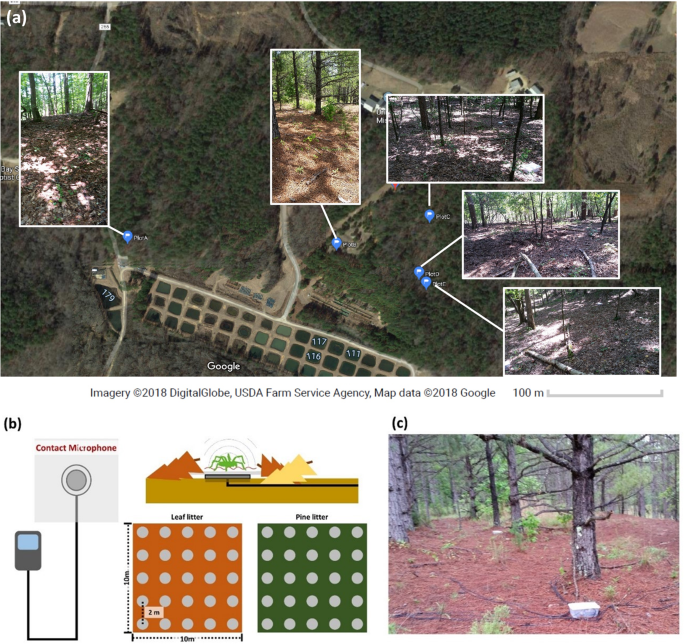Summary made by ChatGPT4
The scientific paper titled “Vibroscape analysis reveals acoustic niche overlap and plastic alteration of vibratory courtship signals in ground-dwelling wolf spiders” presents a detailed study on the communication patterns of Schizocosa wolf spiders. This study aims to expand the understanding of soundscape ecology by incorporating substrate-borne vibrations, termed ‘vibroscapes’. The research is broken down into three key objectives:
Characterizing the deciduous forest floor vibroscape: The study employs contact microphone arrays and automated processing of large audio datasets to analyze vibroscape in a deciduous forest. This includes recording both airborne and substrate-borne sounds.
Quantifying acoustic niche partitioning among three Schizocosa species: The researchers focus on three co-occurring species - S. duplex, S. stridulans, and S. uetzi - examining how they partition the spatial, temporal, and spectral dimensions of the acoustic niche within the vibroscape.
Examining behavioral plasticity in courtship signaling: The study investigates how the abundance of substrate-borne noise and conspecific/heterospecific vibratory signals shape the courtship signaling behavior of these spiders.
The paper presents significant advancements in understanding animal communication, particularly in how environmental factors influence signaling behavior in spider species. It addresses the challenges of studying communication in non-audible modalities and offers a comprehensive view of how closely related species share and adapt to their acoustic environments. This research opens avenues for future studies on ecological and evolutionary dynamics in animal communication. Discovery Details
The study’s key discoveries include:
-The characterization of a natural vibroscape, which involved developing techniques for collecting and analyzing substrate-borne field vibrations. -Quantification of acoustic niche overlap among the three wolf spider species, revealing high overlap in S. stridulans and S. uetzi. -Behavioral plasticity in response to vibroscape noise, with species-specific variations in courtship signaling in response to the abundance of noise and the presence of conspecific or heterospecific signals.
Methodological Breakdown
Methodologically, the study stands out for its innovative use of contact microphone arrays and automated processing to analyze large audio datasets. This approach allowed for a comprehensive and detailed understanding of the acoustic environment and the behaviors of the wolf spiders within it. The study effectively combined field recordings with statistical analyses to explore the intricate details of acoustic niche partitioning and behavioral adaptations.
Challenges and Opportunities
A notable challenge in this research was the difficulty in capturing and analyzing substrate-borne vibrations, a less studied aspect of acoustic communication. The study’s innovative methodologies open opportunities for further research in this area, particularly in understanding how environmental factors influence communication and behavior in a broader range of species.
TLDR
This paper presents a groundbreaking study on the vibroscape of ground-dwelling wolf spiders, focusing on acoustic niche overlap and behavioral adaptations in their courtship signaling. It employs novel techniques for analyzing substrate-borne vibrations, revealing intricate details of spider communication and opening new research directions in soundscape ecology.
AI Thoughts
The findings have broader implications for understanding animal communication, particularly in the context of environmental influences on behavior. This research could pave the way for similar studies in other species and ecosystems, enhancing our comprehension of ecological interactions and evolutionary processes. It also highlights the importance of considering various sensory modalities in ecological research, potentially influencing conservation strategies and our understanding of biodiversity.


